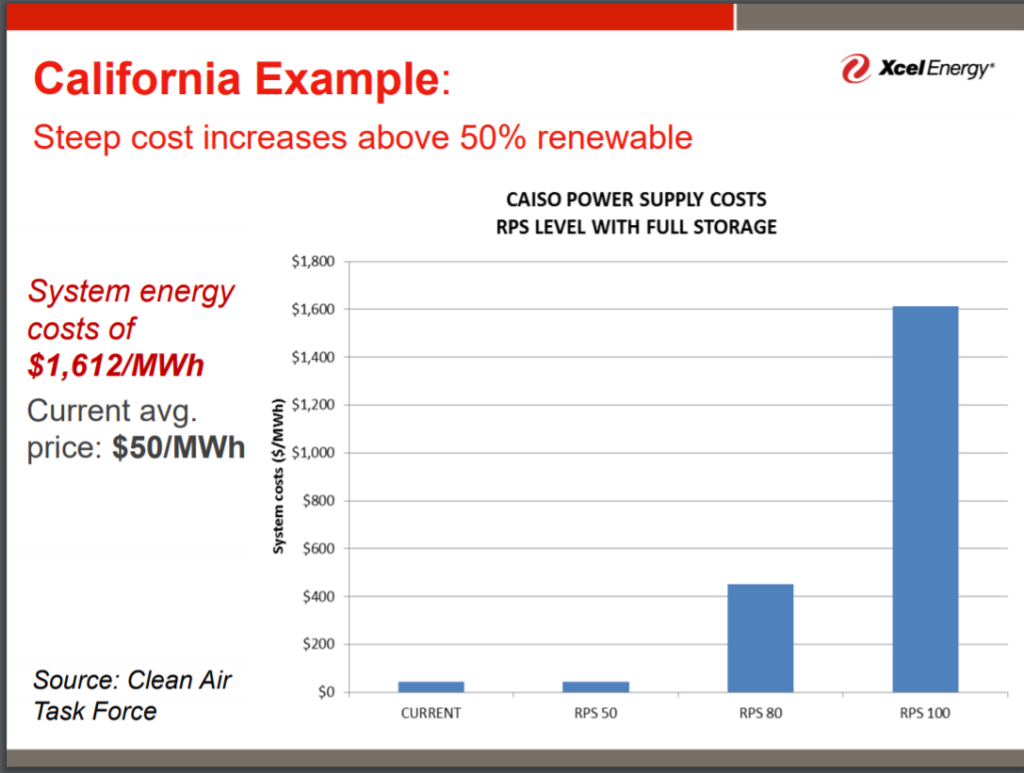100 Percent Wind+Solar+Batteries= $1,036.80 Monthly Electric Bill, According to An Xcel Energy Slide Show and EIA Data
In April of this year, Gov. Tim Walz’s administration suggested the economics of nuclear power likely make it too expensive to be part of his plan to produce 100 percent of Minnesota’s electricity from carbon-free sources by 2050. Instead, the administration argued technological improvements would allow wind, solar, and battery storage technology to reliably and affordably meet Minnesota’s energy needs.
A slide show produced by Xcel Energy suggests the Governor couldn’t be more wrong.
This slideshow was presented to the Midwestern Governor’s Association meeting in March of 2019. One would assume someone from the Governor’s office would be at the meeting, but just in case, I’ve included the slideshow at the end of this post. For now, I’d like to show you one slide.
This slide shows the enormous cost of using 100 percent renewable energy with battery backup in California. You’ll notice that the cost of electricity increases exponentially as renewable and battery storage penetration increases to $1,612 per megawatt hour ((MWh) compared to an average system cost of $50 per MWh today.

These costs appear to be a wholesale system prices for electricity, not a retail rates, meaning the $1,612 per MWh figure does not include things that are normally added to the bill in the retail prices of electricity like transmission, distribution, utility profits, property taxes etc.
What would this mean for families in Minnesota, if we assume that achieving a grid powered by 100 percent wind, solar, and batteries would have the same system cost as Xcel claims it would cost in California?
If we just use the wholesale cost of $1.60 per kilowatt hour and ignore the factors in the retail costs, electricity prices would be 11 times higher than the current price of electricity for residential customers Xcel Energy’s service territory. This means the average Minnesota household with Xcel as their energy provider using 648 kilowatt hours per month would see their average monthly bill increase from about $91.30 to $1,036.80, or more than $12,000 per year.
It is important to stress that the wholesale cost of electricity using wind, solar, and batteries would be 50 times more expensive than the electricity produced by the Sherburne County coal units, which Xcel Energy wants to shut down decades before the end of their useful lifetimes and replace these with solar, wind, natural gas, and 1.700 MW of “firm peaking”capacity, which could mean natural gas, and could mean batteries.

Astonishingly, Governor Walz and “progressive” members of the House of Representatives think that Minnesota will be able to go 100 percent “carbon free” using only wind, solar, and batteries, and result in lower costs for consumers. This is nothing more than a fairy tale. The reality of the situation is that wind, solar, and battery storage would consume 18 percent of the median household income in Minnesota.
If these lawmakers truly believe climate change is an existential crisis, they must pull their heads out of the sand and work to lift the ban on new nuclear power plants, begin researching technologies like carbon capture and sequestration, and allow large hydro to qualify for carbon-free standards, immediately. Otherwise, they simply cannot be taken seriously on the subject.
Xcel Energy Midwest Governors Association